BOUTIQUEResouces
Plant photosynthesis comprises steps such as light energy absorption, energy conversion, electron transport, ATP synthesis, and CO? fixation. This process is mainly completed on the thylakoid membranes of plant chloroplasts.
Four critical protein complexes are present on the thylakoid membrane: Photosystem II (PS II), Cytochrome b6/f complex (Cytb6/f complex), Photosystem I (PS I), and ATP synthase. These four complexes act synergistically to collectively accomplish the light-dependent reactions.
Photosystem II is equipped with an antenna system composed of Light-Harvesting Complexes (LHC), which can capture light energy. In contrast, Photosystem I utilizes the captured energy to carry out primary photochemical reactions. The Cytb6/f complex plays a vital role in the process of electron transport, while ATP synthase is responsible for synthesizing ATP, which provides energy for plant cells.
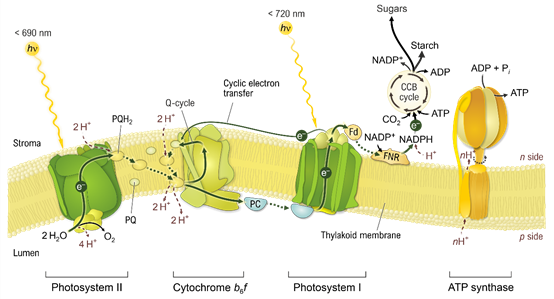
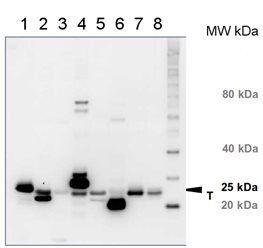
AS09 522應(yīng)用示例
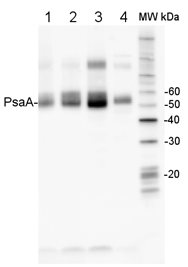
AS06 172應(yīng)用示例
Reference
Sulli et al. (2023). Generation and physiological characterization of genome?edited Nicotiana benthamiana plants containing zeaxanthin as the only leaf xanthophyll. Planta . 2023 Oct 5;258(5):93. doi: 10.1007/s00425-023-04248-3.
Ye et al. (2023). The light-harvesting chlorophyll a/b-binding proteins of photosystem II family members are responsible for temperature sensitivity and leaf color phenotype in albino tea plant. J Adv Res . 2023 Dec 25:S2090-1232(23)00404-6.doi: 10.1016/j.jare.2023.12.017.
Penzler et al. (2024). A pgr5 suppressor screen uncovers two distinct suppression mechanisms and links cytochrome b6f complex stability to PGR5. Plant Cell. 2024 Mar 27:koae098. doi: 10.1093/plcell/koae098.
Mu et al. (2024). Plastid HSP90C C-terminal extension region plays a regulatory role in chaperone activity and client binding.Plant J. 2024 Jul 5.doi: 10.1111/tpj.16917.
Rubisco
CO? fixation is the process of synthesizing organic compounds using ATP and NADPH produced by the light-dependent reactions, and this process is known as the Calvin cycle.
Ribulose-1,5-bisphosphate carboxylase/oxygenase (Rubisco) is the key rate-limiting enzyme in CO? fixation. It catalyzes the carboxylation of CO? and RuBP (ribulose-1,5-bisphosphate), which is then cleaved to form two molecules of PGA (3-phosphoglycerate).
All photosynthetic organisms possess Type I Rubisco, which consists of 8 large subunits (RbcL) and 8 small subunits (RbcS). Notably, the folding of RbcL into its native state depends on the action of CPN60—a molecular chaperone localized in chloroplasts.

|
Product Name |
Item Nubmer |
Lab Type |
|
CAH3 | Carbonic anhydrase |
AS05 073 |
IF, IG, WB |
|
CPN60A1 | Chaperonin 60 subunit alpha 1, chloroplastic |
AS12 2613 |
WB |
|
CsoS1A/B/C | Major carboxysome shell protein 1A, AB, 1C |
AS14 2760 |
WB |
|
EPSP synthase | 3-phosphoshikimate 1-carboxyvinyltransferase |
AS14 2782 |
WB |
|
EPYC1 | Essential Pyrenoid Component 1 |
AS19 4312 |
WB |
|
Lci5 | Low carbon dioxide induced protein number 5 |
AS05 090 |
IHC, WB |
|
NADP-ME | NADP-malic enzyme, chloroplastic (dicots/monocots) |
AS21 4580 |
WB |
|
PEPC | Phosphoenolpyruvate carboxylase |
AS09 458 |
IL, WB |
|
PEPCK | PEP carboxykinase |
AS07 241 |
WB |
|
PRK ribulose-5-P-kinase | Phosphoribulokinase |
AS07 257 |
WB |
|
RA | Rubisco activase |
AS10 700 |
WB |
|
RAF2 | Rubisco accumulation factor 2 |
AS13 2729 |
WB |
|
RbcL | Rubisco large subunit, form I (rabbit) |
AS03 037 |
IF, IG, TP, WB |
|
RbcL II | Rubisco large subunit, form II |
AS15 2955 |
IF, WB |
|
RbcS | Rubisco small subunit (SSU) |
AS07 259 |
WB |
|
RbcS | Rubisco small subunit (Algal) |
AS22 4825 |
WB |
|
Rubisco | 557 kDa hexadecamer |
AS07 218 |
IL, WB |
|
Rubisco ELISA quantitation kit |
AS15 2994 |
WB |
|
SBPase | Sedoheptulose-1,7-bis phosphatase |
AS15 2873 |
WB |
|
TKL1 | Transketolase (chloroplastic) |
AS15 2903 |
IP, WB |
|
Trxf1/2 | Thioredoxin F1/F2 (chloroplastic) |
AS14 2808 |
WB |
|
TrxM1/M2 | Thioredoxin M1/M2 (chloroplastic) |
AS14 2809 |
WB |
Application Cases
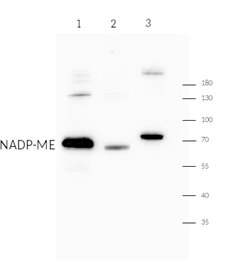
AS21 4580應(yīng)用示例
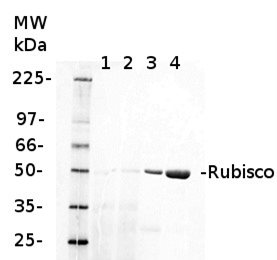
AS03 037應(yīng)用示例
Partial Reference
Phukan et al. (2024). Externally supplied ascorbic acid moderates detrimental effects of UV-C exposure in cyanobacteria. Photochem Photobiol Sci. 2024 Jul 12. doi: 10.1007/s43630-024-00612-8.
Zhao et al. (2024). Psb28 protein is indispensable for stable accumulation of PSII core complexes in Arabidopsis.Plant J. 2024 May 26. doi: 10.1111/tpj.16844.
Ciesielska et al. (2024). S2P2-the chloroplast-located intramembrane protease and its impact on the stoichiometry and functioning of the photosynthetic apparatus of A. thaliana. Front Plant Sci. 2024 Mar 15:15:1372318. doi: 10.3389/fpls.2024.1372318.

Agrisera (Sweden) Distributed by Ximeijie
Founded in 1980, Agrisera AB (Sweden), distributed by Ximeijie, has long been dedicated to developing high-quality plant monoclonal and polyclonal antibodies. Leveraging its outstanding R&D capabilities and production technology, the company holds a leading position in the global plant antibody field.
Its product line covers a wide range of species. Agrisera’s product catalog includes antibodies targeting numerous model plants and major crops—such as Arabidopsis thaliana, rice, wheat, maize, and tomato—spanning over 30 plant species. This forms an extensive antibody library that meets the diverse needs of various plant science research projects.
Moreover, the company’s products are supported by a large number of published literatures, which ensures the accuracy and reliability of research results.
Beijing XMJ Technology Co., Ltd.
Beijing XMJ Technology Co., Ltd. is the authorized distributor of the Agrisera brand in China, dedicated to providing high-quality immunological products and services to a wide range of scientific researchers across the country. If you are interested in the aforementioned products, you are welcome to call XMJ's national customer service hotline at 400-050-4006 or visit the official website at www.gq44.cn for more information.



.png) 京公網(wǎng)安備 11010802028692號
京公網(wǎng)安備 11010802028692號